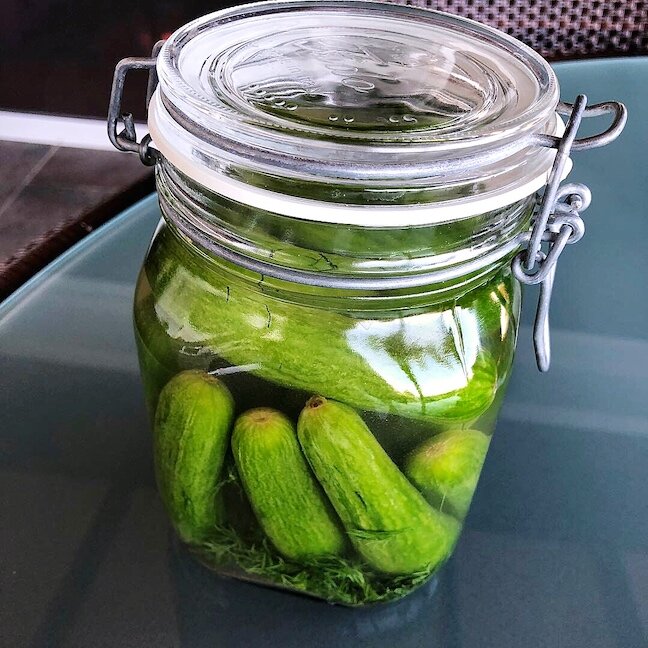Homemade Pickles
GLUTEN FREE · VEGAN · NUT FREE · PALEO · AIP
(This post contains affiliate links.)
Although it has been around forever (as an effective method of preserving certain foods), fermentation and fermented foods have more recently become elevated in the public consciousness as an important element in eating for health. This is because of their status as a probiotic food, meaning they are chock-full of the good bacteria needed for optimum gut health. Fermented foods are truly key to any gut-friendly way of eating, plus they happen to be delicious, so it’s a win-win!
FERMENTED VS PICKLED?
Many pickles, like the kind you buy in the supermarket, are not fermented but instead use vinegar as a preservative. You can make your own pickles using vinegar as well of course, but they don’t have the gut-supporting bacteria and benefits that fermented foods do.
This homemade pickle recipe uses a process called lactic acid fermentation (also known as lacto-fermentation). Instead of vinegar, fermented pickles are preserved with the acid created by the fermentation process. Under the right conditions (ie the salty environment created in the jar), lactobacilli bacteria naturally found on the surface of veggies will create lactic acid, which in turn prohibits the growth of other bacteria, yeasts or mould. Most bacteria and microorganisms cannot survive in the salty environment, but lactobacilli can and they multiply by feeding on the natural sugars present in the veggies.
Lactobacilli are key players in a healthy gut microbiome, overall immunity and even mental health. People with IBD tend to have lower levels of good bacteria in their gut, and when this happens, the gut’s in-built anti-inflammatory features (that exist in healthy individuals) are compromised and can result in a flare of the disease. Probiotics can help restore balance to the gut, which can help to regulate inflammation and even improve IBD symptoms. While probiotic supplements are great and widely-available, eating fermented foods is an easy and inexpensive way to boost your good bacteria numbers and give your hard-working gut a helping hand!
THE INGREDIENTS
Cucumbers
Ideally you want to get small or so-called ‘pickling’ cucumbers, but regular cucumbers work just fine. You could also slice them instead of using them whole, if you prefer.
Dill
Dill is such a wonderful herb, and is key in creating the delicious pickle flavour.
Garlic
If you like your pickles super garlicky, then feel free to use more garlic cloves that I have!
Salt
The magical fermentation ingredient, salt is really what drives the lactic acid fermentation process, inhibiting microorganisms that could spoil the veggies and allowing the lactic-acid-producing bacteria to grow, multiply and colonise the ferment.
Water
To ensure the salt is fully dissolved, you can boil the water and then add the salt. You will then need to let the water cool before adding it to the cucumbers. Otherwise, just use water at room temperature and spend a little more time stirring. It doesn’t matter if the salt is not 100% dissolved.
CHANGES & SUBSTITUTIONS
You can try this recipe with other veggies, not just cucumbers. How about trying out carrots, radishes or peppers?
TIPS
If you have trouble keeping the cucumbers below the water level, you may want to try using a Pickle Pebble.
Once your jar is ready to go into its dark cupboard, place it on a cloth or paper towel in case of leaks, saving on the potential clean-up later!
Some people recommend ‘burping’ the jars to release the build up of gas. I almost never feel the need to do this, but it’s up to you. You can even get a little gadget called a Pickle Pipe to place on your jar to help with that!
HOMEMADE PICKLES

Ingredients
- 2 cloves of garlic
- generous handful fresh dill
- 12-15 small cucumbers (depending on the size of the jar)
- 2 - 2 1/2 cups filtered water
- 2 tbsp sea salt
Instructions
- Sterilise your mason jar by rinsing it with boiled water (watch your hands!). Dry with a paper towel and allow to cool down before placing ingredients.
- Drop garlic cloves into the jar.
- Add the fresh dill, pushing it to the bottom of the jar, laying it relatively flat.
- Add in the cucumbers: fit in as many as you can standing vertically, ensuring they are tightly packed together. You will need to leave around 2-3cm between your topmost cucumber and the jar lid. If you have the space, lay some horizontal cucumbers on top of the vertical ones, again ensuring they are tightly packed. You don't want the cucumbers to be able to move about once the water is added, as they need to stay fully submerged, both for optimum lactic acid fermentation and also to avoid the formation of mold.
- Stir the sea salt into the filtered water until it dissolves, then pour into the jar, ensuring the cucumbers are fully covered with water. Don't fill the jar all the way to the top though - leave at least 1cm between the water level and the jar lid.
- If any cucumbers pop up and float, try placing a rolled-up cabbage leaf or a Pickle Pebble on top to keep them in place.
- Close the jar and place in a dark cupboard, on a cloth or paper towel (in case of leaks).
- Leave for 3 days before eating, then transfer to the fridge.
Notes:
· The formation of bubbles is normal and a sign of effective lactic fermentation. These bubbles can increase the pressure inside the jar and cause the water level to rise, even resulting in some leakage from where the jar meets the lid. This is nothing to worry about. · There may be a little salt 'residue' on the tops of the cucumbers, which is fine, but if you see any mould or fluff on the surface, then it's best to throw it away.

